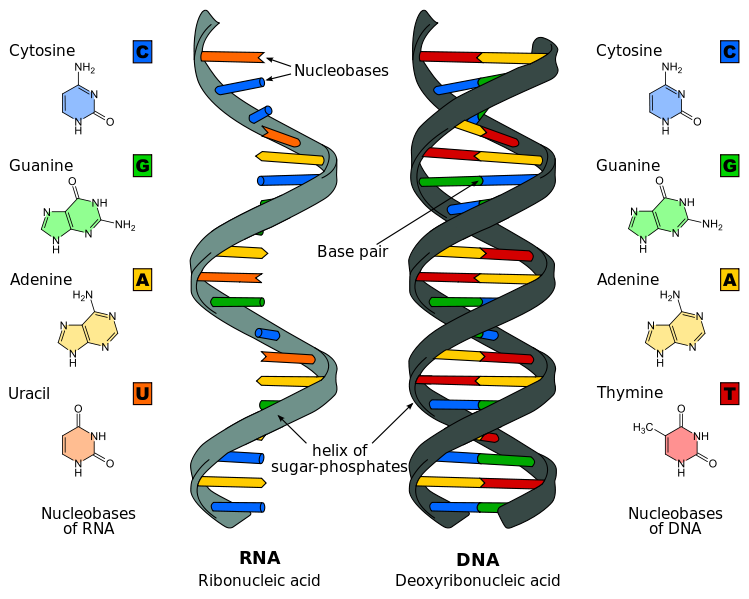But first I need to explain what the genetic code is.
DNA is the code for life, right? But what does that really mean? Well DNA actually contains the instructions that tells cells how to make proteins. And proteins are nature's mini-machines that make all living things work. They are like tiny robots that are involved in just about everything that goes on in your body. There are proteins that digest food, others that fight diseases and some that help make other proteins. Not only that but they hold your body together; skin, hair, muscles, cartilage and ligaments are all made from protein.
So all the information on how to make proteins is contained in DNA. This information is written as a string of 4 bases called adenine, thymine, guanine, and cytosine which are abbreviated to A, T, G and C.
 |
| RNA vs DNA |
Now proteins are made up of stings of 22 possible amino acids, which are also abbreviated to single letters codes.
 |
| Amino acids and their 3 letter and 1 letter codes |
So how does the 4 letter code of DNA get translated into a 22 letter code of proteins?
First off the DNA gets transcribed into RNA (which is like DNA but it is sometimes single stranded instead of double stranded like DNA, and secondly it has uracil (U) instead of thymine (T)).
To work out what protein sequence the RNA codes for you need to read it in groups of three bases. For example the sequence AUGGGAGGG would get split up into AUG GGA GGG. Each of these groups of three bases are called codons and each codon represents an amino acid. You can work out which amino acids a sequence codes for using the genetic code in this table.
 |
| The Genetic Code (click for a bigger version) |
So AUG codes for M, GGA codes for G and GGG also codes for G.
In the genetic code table there are 25 letters (X is missing) so we can spell stuff out using codons instead of the full alphabet.
How we've got that sorted lets make the jewellery.
You'll need:
What to do:
1) First decide what you want to spell out using the code. How about starting with your name?
2) Now figure out what codons you need to spell out your name.
So in my case I want to spell out 'Mark'. So I need the codons AUG GCG AGA AAA.
3) Next select the coloured beads that represent the bases. So AUG is blue, red, yellow. The GCG is yellow, green, yellow.
4) Finally thread the beads onto the string in that order. Tie it off and hey presto a bracelet with your name spelt out in the genetic code.
Why are there more codons than amino acids?
There are 4 bases and codons consist of 3 bases. So that makes 64 possible codons. But there are only 22 amino acids (and in most organisms there are actually only 20). Which means that there are loads more codons than amino acids. This means that there are some spares, which turns out to be quite handy, because its suppresses the effects of mutations. For example, if ACC got mutated into ACG it wouldn't make any difference because they both code for the same amino acid.
Why do some codons say 'STOP'?
Genes always end in a STOP codon. It signals the end of a protein, its sort of like the full stop at the end of a sentence. If you fancy it put a STOP at the end of your sequence.
Why do some STOPs have have U or O after them?
U and O are the two rare amino acids. Most organisms don't use them. But when they do crop up they code for U and O instead of STOP.
How come some of the codons have two letters after them?
22 of the letters represent individual amino acids. Plus there's Z, B and J which are used for some of amino acids that are quite similar. So if a biochemist isn't sure if she's got a I or a L in her protein then she'll write down J.
I've got an X in my name what do I do?
You'll have to cheat, maybe use one of the stop codons instead.








